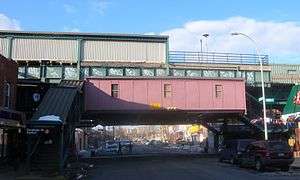Saratoga Avenue (IRT New Lots Line)
| Saratoga Avenue | |||||||||||
|---|---|---|---|---|---|---|---|---|---|---|---|
| New York City Subway rapid transit station | |||||||||||
 | |||||||||||
| Station statistics | |||||||||||
| Address |
Saratoga Avenue & Livonia Avenue Brooklyn, NY 11212 | ||||||||||
| Borough | Brooklyn | ||||||||||
| Locale | Brownsville | ||||||||||
| Coordinates | 40°39′42″N 73°54′56″W / 40.661531°N 73.915586°WCoordinates: 40°39′42″N 73°54′56″W / 40.661531°N 73.915586°W | ||||||||||
| Division | A (IRT) | ||||||||||
| Line | IRT New Lots Line | ||||||||||
| Services |
2 3 4 5 | ||||||||||
| Transit connections |
| ||||||||||
| Structure | Elevated | ||||||||||
| Platforms | 2 side platforms | ||||||||||
| Tracks | 2 | ||||||||||
| Other information | |||||||||||
| Opened | November 22, 1920 | ||||||||||
| Traffic | |||||||||||
| Passengers (2015) |
2,442,282[1] | ||||||||||
| Rank | 199 out of 422 | ||||||||||
| Station succession | |||||||||||
| Next north |
Sutter Avenue–Rutland Road: 2 | ||||||||||
| Next south |
Rockaway Avenue: 2 | ||||||||||
| |||||||||||
| |||||||||||
Saratoga Avenue is a station on the IRT New Lots Line of the New York City Subway. Located at the intersection of Saratoga Avenue and Livonia Avenue in Brownsville, Brooklyn, it is served by the 3 train at all times except late nights, when the 4 train takes over service. Occasional 2, 4 and 5 trains serve this station during rush hours.
Station layout
| P Platform level |
Side platform, doors will open on the right | |
| Northbound | ← | |
| Center trackway | → No track or roadbed | |
| Southbound | → | |
| Side platform, doors will open on the right | ||
| M | Mezzanine | Station agent, MetroCard vending machines, fare control |
| G | Street Level | Exit/ Entrance |
This elevated station, opened on November 22, 1920,[4] has two side platforms and two tracks with space for a center track that was never installed. Both platforms are longer than the standard IRT train length of 510 feet and have beige windscreens and brown and red canopies with green canopies with green frames and support columns for their entire length except for a small section at the west (railroad north) end. Here, they have waist-high black steel fences with two lampposts and one standard black station sign in white lettering in-between them. The windscreens and canopy frames also have black and white station signs.
The station's only entrance/exit is an elevated station house beneath the tracks at the extreme east (railroad south) end. Inside fare control, it has a waiting area that allows a free transfer between directions, one staircase to the Manhattan-bound platform and two to the New Lots Avenue-bound one. One of those staircases is built adjacent to the platform instead of directly on it and connected to the station house with a wooden elevated passageway. Outside fare control, there is a turnstile bank, token booth, and three staircases going down to all corners of Saratoga and Livonia Avenues except the northeast one.
The station house has several enamel white-on-navy blue "To Street" porcelain signs directing passengers to the street stairs,[5] one of which also has porcelain signs of the same style at the bottom of the canopy that says, "Interborough Rapid Transit Company: To All Trains."[6]
References
- ↑ "Facts and Figures: Annual Subway Ridership". Metropolitan Transportation Authority. Retrieved 2016-04-19.
- ↑ Occasional 2 trains to Wakefield–241st Street and 5 trains to Nereid Avenue and Dyre Avenue also serve the station during rush hours.
- ↑ Occasional 2 5 trains also serve this station during rush hours.
- ↑ "Annual report. 1920-1921.". HathiTrust. Interborough Rapid Transit. Retrieved 2016-09-05.
- ↑ "To Street" porcelain sign (The Subway Nut)
- ↑ IRT "To All Trains" porcelain sign (The Subway Nut)
External links
-
 Media related to Saratoga Avenue (IRT New Lots Line) at Wikimedia Commons
Media related to Saratoga Avenue (IRT New Lots Line) at Wikimedia Commons - nycsubway.org – Brooklyn IRT: Saratoga Avenue
- Station Reporter — 3 Train
- The Subway Nut — Saratoga Avenue Pictures
- Saratoga Avenue entrance from Google Maps Street View



